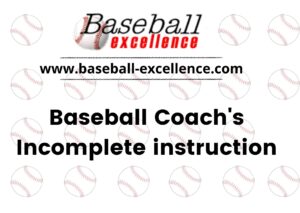The pitching coach should observe his pitcher carefully during the course of a game. Since the game is played one pitch at a time the coach should observe every pitch he throws.
These are the things we look for when our pitcher is on the mound in a game.
- What is his demeanor? Is he keeping his poise? Does he display self-confidence? Does he keep that positive demeanor when he gives up a few hits, or his teammate makes an error?In big games is he relaxed? I went to the mound in a championship tournament game this past summer after our centerfielder committed an error allowing two runs to score.Our pitcher had lost his focus and was lamenting the error. His eyes were very wide and I could see he was quite tense.I asked him to hold out his arm and I felt the underneath side of his forearm. It was as tight as a guitar string. Those tight muscles were restricting the flexibility of his wrist, flattening out his pitches and affecting his velocity. I had him massage it to loosen it up a little and told him to focus only on hitting the glove. To ignore the consequences of the pitch; “Hit the glove.” Nothing else matters.It is very easy for young pitchers to get caught up in the moment and lose their focus. I saw several instances of it in the LL World Series as well. When that happens, pitchers lose their ‘looseness.’ (For want of a better word) They have a tendency to overthrow and their fastball flattens out, making it more ‘hittable.’It is the pitching coach’s job is to help keep his pitcher loose and relaxed- often a difficult job in big games.Humor is a great tool. It can serve to put the moment in perspective and take some of the burden off the pitcher’s shoulders.I often see coaches take themselves so seriously that all perspective is lost and they themselves become tense and overbearing; as if their actions could control the outcome of the game.A word of advice to young coaches- “Act like you’ve been here before.” Any negative emotions or body language will be immediately picked up by your players.Help your pitcher succeed; don’t hinder him.
- Are his pitches staying down in the strike zone?When a pitcher has his mechanics working well, his arm will be up at shoulder height and his pitches will be released on a downward plane. His front shoulder will be closed at landing and he will have good movement on his pitches.The two most dangerous times in a game is early on and in the later innings.Early in the game he may be overthrowing and his mechanics will break down, – causing his pitches to come up.It is, in my opinion very important for the coach to monitor this time in the game. Just telling him to get his pitches down will not be beneficial to him. That’s like saying, “throw strikes.” Don’t you think your pitcher is trying to throw strikes?Look for the root cause and a trip to the mound may be called for. There is nothing wrong in going to the mound early in the game to settle your pitcher down. But have something constructive to say. And say it in a calm, gentle manner. He may just be nervous so remind him to breathe properly.Even if you pinpoint the cause of his problem and he understands your instruction there is no guarantee he will settle down and be effective. When that happens make a mental note to address the problem for future games.In the later innings fatigue may be the reason for a pitcher to lose his effectiveness. It is important that the coach understand that time in the game as well. Fatigue will cause pitches to come up and lose their effectiveness.Look at his balance point. Is it consistent with his delivery early in the game?Is he rushing, trying to ‘get it over with’? Rushing and an inconsistent balance point will impede his regular arm action with the result being a low arm slot.The arm will not get to shoulder height and pitches will be up; either up in the zone making them hittable or up out of the zone.All pitchers, from LL to the major leagues struggle with release points and rushing at times. If the pitching coach will address them immediately he will give his pitcher a better chance of staying on track.Look at his face. If he is tiring there may be signs in his facial expression.
- Is your pitcher getting behind in the count? Is he struggling to get ahead?
Consistent 2-0 and 3-1 counts are a recipe for disaster. This may be the result of the factors we have mentioned earlier.My suggestion is to give him a chance to get back on track but have your bullpen at the ready. - Does your pitcher demonstrate a reluctance to throw strikes after giving up a few key hits? It is important for the coach to know the difference between a physical cause and a mental one. After giving up a home run or a big hit does your pitcher come back with strikes or is he inside-outside, off the plate?You are looking for fear; fear and even lack of heart. This is the one time I will visit the mound and be forceful with my pitcher.First I go through my mental checklist; are his mechanics good, has he been effective earlier, what is his pitch count, does his ball have movement?If I can rule out the physical then I go to the mound to see what my pitcher is made of.Questions I have asked in that situation are:” Do you want to come out of the game? Are you afraid? Are you hurt? Do you realize what you’re doing?”“Then it’s time for you to grow up and compete. Show me what you’re made of. Bear down and throw strikes.” (It’s the one time I say “Throw strikes.”)A coach has to have a little amateur psychologist in him. And he has to say these things at the right time and in the right situation; and at the right age. (LL age is probably too early?)I believe that if you have a pitcher with talent but lacking in the ‘heart’ department it is your responsibility to point it out to him; to help him understand what it takes to compete.This can be shaky ground for a coach so it is important to get to know his pitchers well. Not all personalities will respond to this approach. But a player must learn to compete in order to advance.Successful pitchers are mentally tough. The coach can help him.There is an old saying; “Yeah he throws great bullpens but he doesn’t do so well when he pitches where the grass grows all around the mound.”
- Pay attention to your pitcher’s rhythm, his tempo.It should be consistent throughout the game. I have seen pitchers slow down their delivery in dangerous situations and the results are often poor.I can recall a playoff high school game last year where the pitcher lost a game because he slowed his rhythm. Throughout the game his tempo was 1, 2, 3, 4, 5; a nice free flowing delivery.Late in the game with a runner on third base he pitched from the windup and dramatically slowed his delivery; 1–2–3–4–5. This inconsistency caused his command to suffer, resulting in two bases on balls and an eventual loss. His body didn’t understand what was happening when he reached his balance point and he couldn’t get his arm into his normal arm slot.Is he doing this from fear or is he thinking too much?The coach should pay close attention to this anomaly, especially at crucial times in the game.
- Is his breaking pitch sharp or does it roll? Rolling curve balls often get hit very hard. Be alert for that fault.The reminders/ cues I use are to tell him to make sure he throws ‘over his glove.’ The lead arm should be high and throwing the curve over the glove helps it break. The other cue is to tell him to ‘see the release of the curve out of the corner of his eye.’ This will help him get the pitch down.
He might need to be reminded not to slow his arm down as well.
The pitching coach plays a vital role in the development of his pitching staff.
Game situations provide a great classroom. Pay attention.




